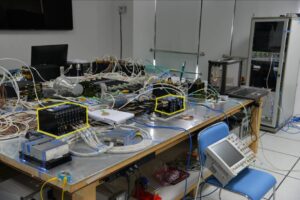Final step before the delivery of the STM telescopes of the French SVOM payload
This is the last step for our models before delivery in China, the CNES teams have just carried out environmental tests on 2 models of the ECLAIRs and MXT telescopes. The objective of these tests is to “qualify” (demonstrate) with sufficient margin the telescopes’ ability to withstand launch conditions and then the hostile space environment throughout the mission.
The purpose of these tests is not to test flight equipment but to test simplified models that are mechanically and thermally representative of future instruments. We are talking about STM models for Structural and Thermal Model. These STM models are defined in such a way as to accurately reproduce the mechanical (same interfaces, same mass, same manufacturing processes, same materials) and thermal (same power dissipation, same thermal leaks) behaviour of flight instruments. However, they are not equipped with detectors or electronic subsystems.
The tests of each telescope were carried out in 3 stages:
- Mechanical vibration tests: the telescope is installed on a shaker, a kind of large loudspeaker that will shake the instrument energetically in various directions and at different oscillation frequencies. Two types of solicitations are applied, sinusoidal and random solicitations. Sinusoidal tests are mainly used to quantify the behaviour and strength of the instrument and to confirm simulation results. Here the movement applied to the instrument takes the form of an oscillation whose frequency increases with time and whose amplitude is calculated in such a way as to reproduce the forces to which the instrument must be able to resist. The randomized test is intended to be much more representative of what the instrument will undergo at launch.
- Mechanical impact tests: the instrument is installed on an “impact table” equipped with pyrotechnic devices. These devices are like miniature cannons. The firing of a small explosive charge propels a metal mass that hits the table. The charge and metal mass are dimensioned to obtain a shock representative of what the instrument must withstand, for example when separating from the launcher or when opening the solar panels.
- Thermal vacuum tests: the telescope is installed here in a tank in which vacuum is made. Various devices, liquid nitrogen-cooled screens and electric heaters allow to expose the instrument to the most extreme temperatures, hot or cold, that it will face in orbit.
The stress levels applied to the instruments during these tests are deliberately higher than those that will be experienced in flight. This makes it possible to cover both the uncertainties on the knowledge of the mechanical and thermal environment experienced throughout the mission and the manufacturing gaps between the STM models and the flight models.
The environmental tests of the STM models of the ECLAIRs and MXT telescopes were carried out at Airbus Defence & Space, which has all the necessary resources on the same technical platform. A CNES team of 30 people mobilized this summer by juggling the availability of test resources in order to be ready for the meeting scheduled with our Chinese partners. Everyone’s efforts have made it possible to achieve all the objectives set and to deliver the equipment on time.
Structural and Thermal Model of the ECLAIRs telescope
Structural and Thermal Model of the MXT telescope

